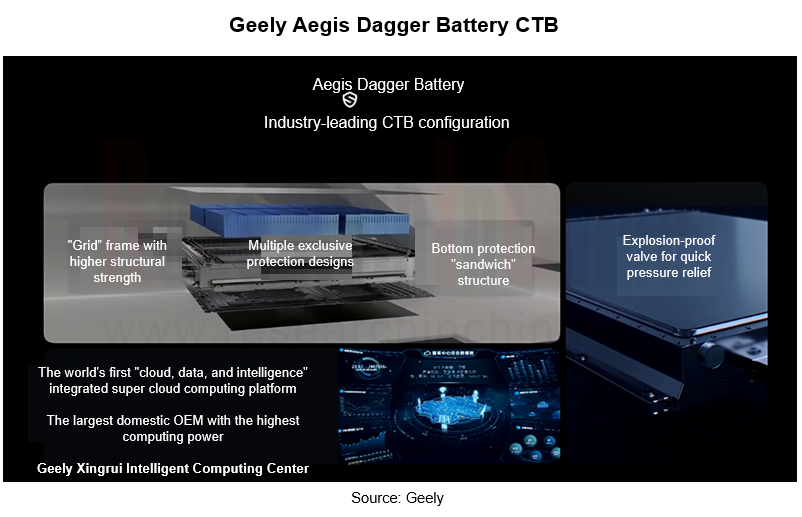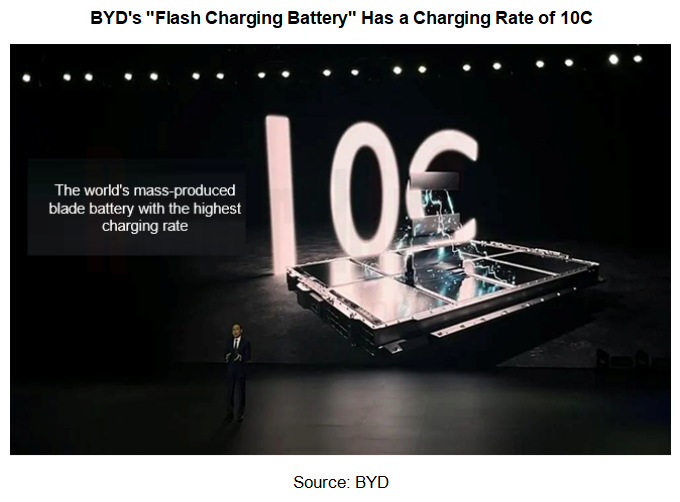Integrated Battery (CTP, CTB, CTC, and CTV) and Battery Innovation Technology Report, 2025
Power battery research: 17 vehicle models use integrated batteries, and 34 battery innovation technologies are released
ResearchInChina released Integrated Battery (CTP, CTB, CTC, and CTV)and Battery Innovation Technology Report 2025, which summarizes the development status, installation, supply layout, etc. of integrated batteries (such as CTP, CTB, CTC, and CTV) and battery innovation technologies, and predicts the development trends of integrated batteries and battery innovation technologies.
1. The application of integrated battery technologies is gradually deepening
Integrated battery technologies include two forms: battery pack integration and body integration. The former is reflected in CTP (Cell to Pack) technology, and body integration exists in the form of CTB (Cell to Body)/CTV (Cell to Vehicle) and CTC (Cell to Chassis).
Integrated battery technologies integrate the battery cells directly into the chassis to increase the range of electric vehicles, enhance body rigidity, improve driving comfort and optimize the Z-axis space in the cabin. According to incomplete statistics, up to 17 models (including those that have been released and planned to be launched) have applied integrated technologies, whose application is constantly deepening.
CTC and CTB were first seen on models of OEMs such as Leapmotor, BYD, Tesla, and Xpeng. Today, car companies such as Changan, Geely, and Avatr have also released their CTB, CTV and other integration technologies.
In April 2024, Geely officially unveiled the latest generation of self-developed and self-produced "blade-type" LiFePO4 batteries: the Aegis Dagger Battery. This battery is further upgraded and iterated on the basis of the original Aegis battery safety system. It adopts CTB and uses the battery as part of the body structure. It was first installed on the Geely Galaxy E5.
The Aegis Dagger Battery has the following features:
The internal battery cell and shell are integrated through structural glue and thermally conductive structural glue, which improves the modal and torsional stiffness of the entire package;
For example, core technologies such as the high-strength steel composite top cover, the highly stable "grid" frame structure, the bottom "armor” of the "sandwich" structure, rapid pressure relief in extreme situations, double thermal and electric separation, the three-phase fusion of "isolation, drainage and conduction", and battery fire prevention have greatly improved the safety of the battery pack.

In March 2025,Leapmotor released CTC 2.0 Plus. CTC 2.0 Plus has improved safety, integration, and intelligence compared to CTC 2.0, and will first land on Leapmoon B10 which is to be launched in April 2025.
Leapao CTC 2.0 Plus has the following upgrades:
Safer: Six-fold ("source + vision + isolation + barrier + evacuation + cooling") safety design; 1,029 safety tests and 128 performance tests; 50% higher side impact coefficient; 20% higher bottom strength; no fire, no explosion, and no heat spread in extreme cases;
More integrated: Integrated design of battery chassis without battery pack; 9-in-1 ultra-integrated battery control system; 19% more power available in the same class;
Smarter: The adaptive AI BMS battery management system can improve battery estimation accuracy by 1%, battery thermal management energy consumption by 30%, and vehicle range by 2%.
2. From 2024 to 2025, battery suppliers successively released 34 battery innovation technologies
In February 2025, BMW's sixth-generation power battery debuted globally, using large cylindrical cells for the first time. It is planned to be first applied to BMW’s first next-generation model to be unveiled this year, as well as the Chinese next-generation models that will be mass-produced from 2026. BMW's upcoming industrial mass production of large cylindrical batteries will undoubtedly fuel the development of such batteries, and also provide a valuable demonstration for the continued breakthroughs in innovative power battery technologies.
According to incomplete statistics, 12 battery suppliers have successively released 34 new battery technologies since 2024, of which CATL has unveiled 7 battery technologies, which are widely used in light/heavy commercial vehicles, hybrid vehicles, buses and other models. CATL has also launched a 6C LiFePO4 battery, which can provide an additional 350 kilometers of range for vehicles in just 10 minutes of charging and will be installed on the Ultium quasi-900V platform in the future.
3. Fast charging batteries upgrade from 6C to 10C
As battery manufacturers and OEMs have deployed high-rate battery technologies, batteries have continued to iterate and break through in the field of ultra-fast charging, evolving from 6C to 10C. For example, CATL launched a 6C LiFePO4 battery, SVOLT Energy released a 6C supercharged battery and Fengxing Short Blade Battery (supercharged version), and EVE unveiled the 6C Omnicel cylindrical battery. OEMs such as FAW and Chery have also actively dabbled in the arena, especially the flash charging battery released by BYD in March this year has a charge and discharge rate of 10C, constantly breaking the industry's upper limit.
For example, in order to completely alleviate users' anxiety about charging, BYD's "flash charging battery" is comparable to "refueling" in charging speed. From the positive electrode to the negative electrode of the battery, it builds an ultra-high-speed ion channel in all directions, reducing the internal resistance of the battery by 50% with the charging current of 1000A and the charging rate of 10C. With the support of 1,000V and 1,000A, the charging power can reach 1 megawatt (1000kW), a 10-second charging offers a range up to 20 kilometers, and a 5-minute flash charging enables a range of 400 kilometers. In terms of performance, the single-module single-motor power reaches 580kW, and the maximum speed exceeds 300km/h. The "flash charging battery" was first available on Han L and Tang L which are expected to be officially launched in April.

4. Batteries for PHEVs and EREVs have become an important development direction for the power battery industry
Batteries tailored for PHEVs and EREVs aim to balance battery-electric range and fast recharging. In order to meet users' needs for daily commuting and long-distance mobility, such batteries not only should support high power output, but also must have fast charging and long lifespan. Given this, power battery manufacturers such as CATL, SVOLT Energy, and CALB are vigorously developing and launching special batteries for PHEVs and EREVs.
In January 2024, CATL released the Freevoy Super Hybrid Battery for the first time with Avatr 12. It plans to apply it to nearly 30 PHEV and EREV models from Geely, Chery, GAC, and Voyah in 2025. In July 2024, SVOLT Energy released the 800V 4C Dragon Scale Armor hybrid battery for PHEVs, which will be mass-produced in July 2025. In January 2025, SVOLT Energy released two types of batteries for PHEVs and EREVs, namely off-road batteries (for plug-in hybrid, extended-range off-road vehicles) and HEV batteries (for commercial vehicles and passenger cars). off-road batteries have been mass-produced and first installed on Tank 500 Hi4-Z.
Autonomous Driving Domain Controller and Central Computing Unit (CCU) Industry Report, 2025
Research on Autonomous Driving Domain Controllers: Monthly Penetration Rate Exceeded 30% for the First Time, and 700T+ Ultrahigh-compute Domain Controller Products Are Rapidly Installed in Vehicles
L...
China Automotive Lighting and Ambient Lighting System Research Report, 2025
Automotive Lighting System Research: In 2025H1, Autonomous Driving System (ADS) Marker Lamps Saw an 11-Fold Year-on-Year Growth and the Installation Rate of Automotive LED Lighting Approached 90...
Ecological Domain and Automotive Hardware Expansion Research Report, 2025
ResearchInChina has released the Ecological Domain and Automotive Hardware Expansion Research Report, 2025, which delves into the application of various automotive extended hardware, supplier ecologic...
Automotive Seating Innovation Technology Trend Research Report, 2025
Automotive Seating Research: With Popularization of Comfort Functions, How to Properly "Stack Functions" for Seating?
This report studies the status quo of seating technologies and functions in aspe...
Research Report on Chinese Suppliers’ Overseas Layout of Intelligent Driving, 2025
Research on Overseas Layout of Intelligent Driving: There Are Multiple Challenges in Overseas Layout, and Light-Asset Cooperation with Foreign Suppliers Emerges as the Optimal Solution at Present
20...
High-Voltage Power Supply in New Energy Vehicle (BMS, BDU, Relay, Integrated Battery Box) Research Report, 2025
The high-voltage power supply system is a core component of new energy vehicles. The battery pack serves as the central energy source, with the capacity of power battery affecting the vehicle's range,...
Automotive Radio Frequency System-on-Chip (RF SoC) and Module Research Report, 2025
Automotive RF SoC Research: The Pace of Introducing "Nerve Endings" such as UWB, NTN Satellite Communication, NearLink, and WIFI into Intelligent Vehicles Quickens
RF SoC (Radio Frequency Syst...
Automotive Power Management ICs and Signal Chain Chips Industry Research Report, 2025
Analog chips are used to process continuous analog signals from the natural world, such as light, sound, electricity/magnetism, position/speed/acceleration, and temperature. They are mainly composed o...
Global and China Electronic Rearview Mirror Industry Report, 2025
Based on the installation location, electronic rearview mirrors can be divided into electronic interior rearview mirrors (i.e., streaming media rearview mirrors) and electronic exterior rearview mirro...
Intelligent Cockpit Tier 1 Supplier Research Report, 2025 (Chinese Companies)
Intelligent Cockpit Tier1 Suppliers Research: Emerging AI Cockpit Products Fuel Layout of Full-Scenario Cockpit Ecosystem
This report mainly analyzes the current layout, innovative products, and deve...
Next-generation Central and Zonal Communication Network Topology and Chip Industry Research Report, 2025
The automotive E/E architecture is evolving towards a "central computing + zonal control" architecture, where the central computing platform is responsible for high-computing-power tasks, and zonal co...
Vehicle-road-cloud Integration and C-V2X Industry Research Report, 2025
Vehicle-side C-V2X Application Scenarios: Transition from R16 to R17, Providing a Communication Base for High-level Autonomous Driving, with the C-V2X On-board Explosion Period Approaching
In 2024, t...
Intelligent Cockpit Patent Analysis Report, 2025
Patent Trend: Three Major Directions of Intelligent Cockpits in 2025
This report explores the development trends of cutting-edge intelligent cockpits from the perspective of patents. The research sco...
Smart Car Information Security (Cybersecurity and Data Security) Research Report, 2025
Research on Automotive Information Security: AI Fusion Intelligent Protection and Ecological Collaboration Ensure Cybersecurity and Data Security
At present, what are the security risks faced by inte...
New Energy Vehicle 800-1000V High-Voltage Architecture and Supply Chain Research Report, 2025
Research on 800-1000V Architecture: to be installed in over 7 million vehicles in 2030, marking the arrival of the era of full-domain high voltage and megawatt supercharging.
In 2025, the 800-1000V h...
Foreign Tier 1 ADAS Suppliers Industry Research Report 2025
Research on Overseas Tier 1 ADAS Suppliers: Three Paths for Foreign Enterprises to Transfer to NOA
Foreign Tier 1 ADAS suppliers are obviously lagging behind in the field of NOA.
In 2024, Aptiv (2.6...
VLA Large Model Applications in Automotive and Robotics Research Report, 2025
ResearchInChina releases "VLA Large Model Applications in Automotive and Robotics Research Report, 2025": The report summarizes and analyzes the technical origin, development stages, application cases...
OEMs’ Next-generation In-vehicle Infotainment (IVI) System Trends Report, 2025
ResearchInChina releases the "OEMs’ Next-generation In-vehicle Infotainment (IVI) System Trends Report, 2025", which sorts out iterative development context of mainstream automakers in terms of infota...